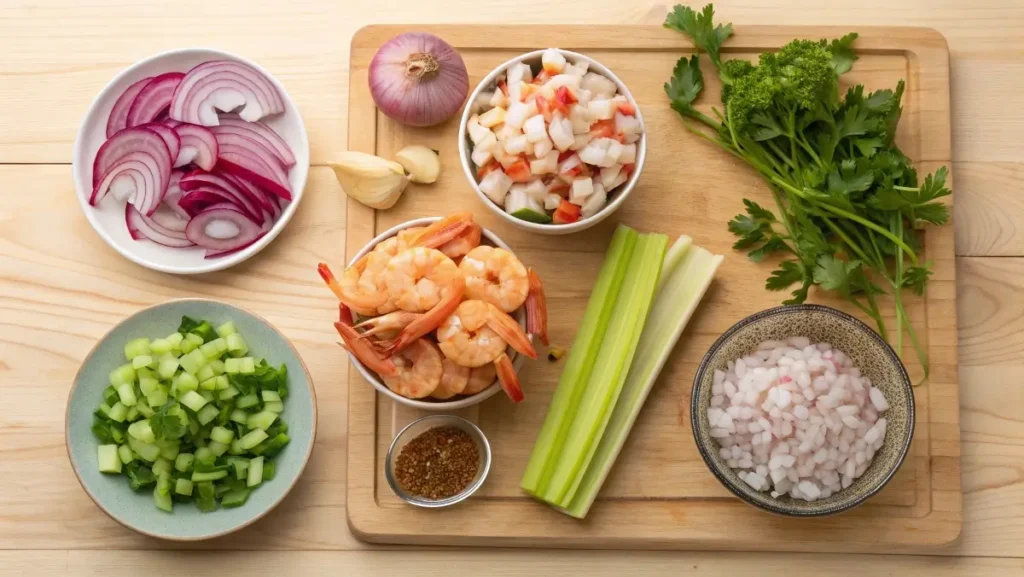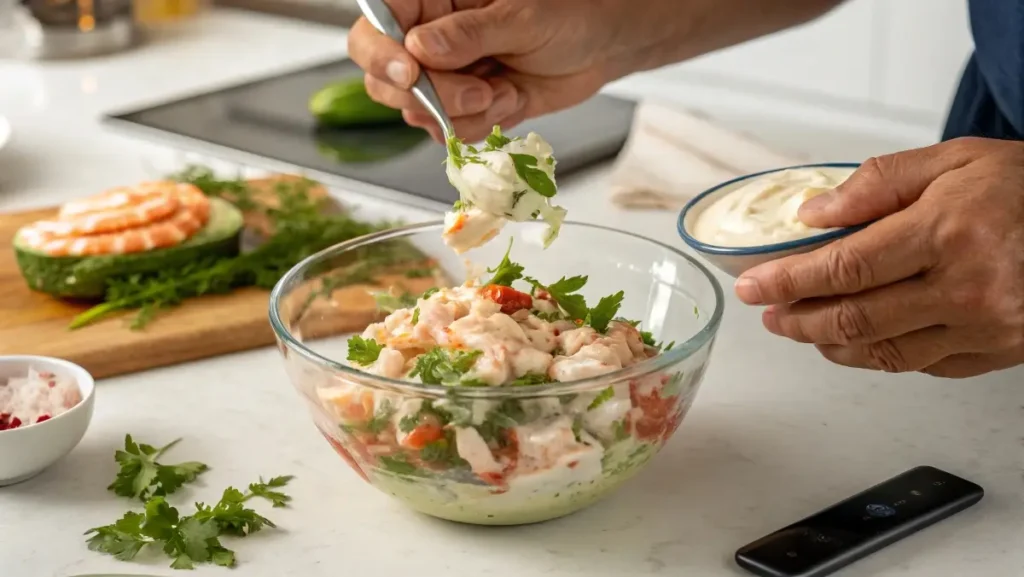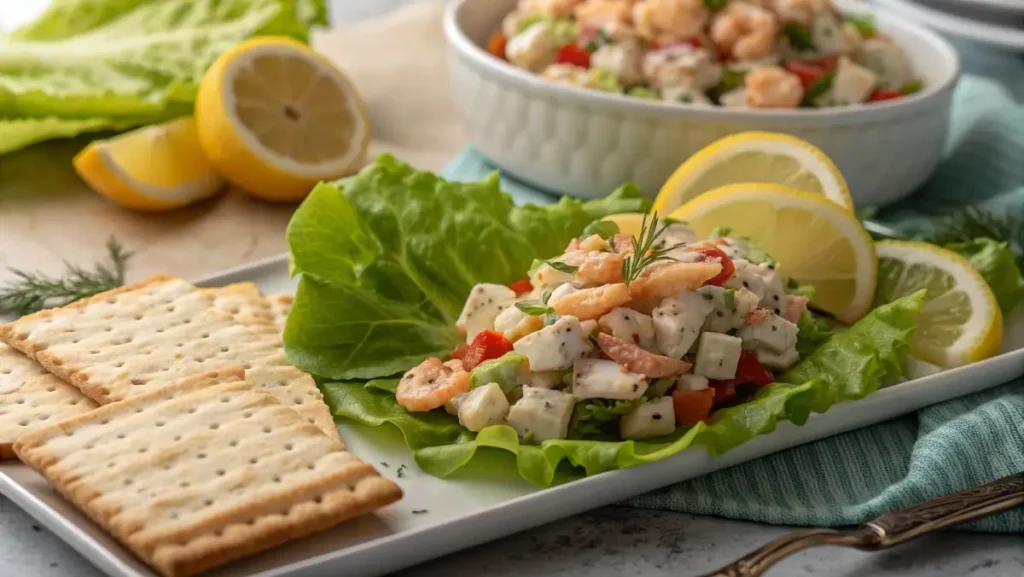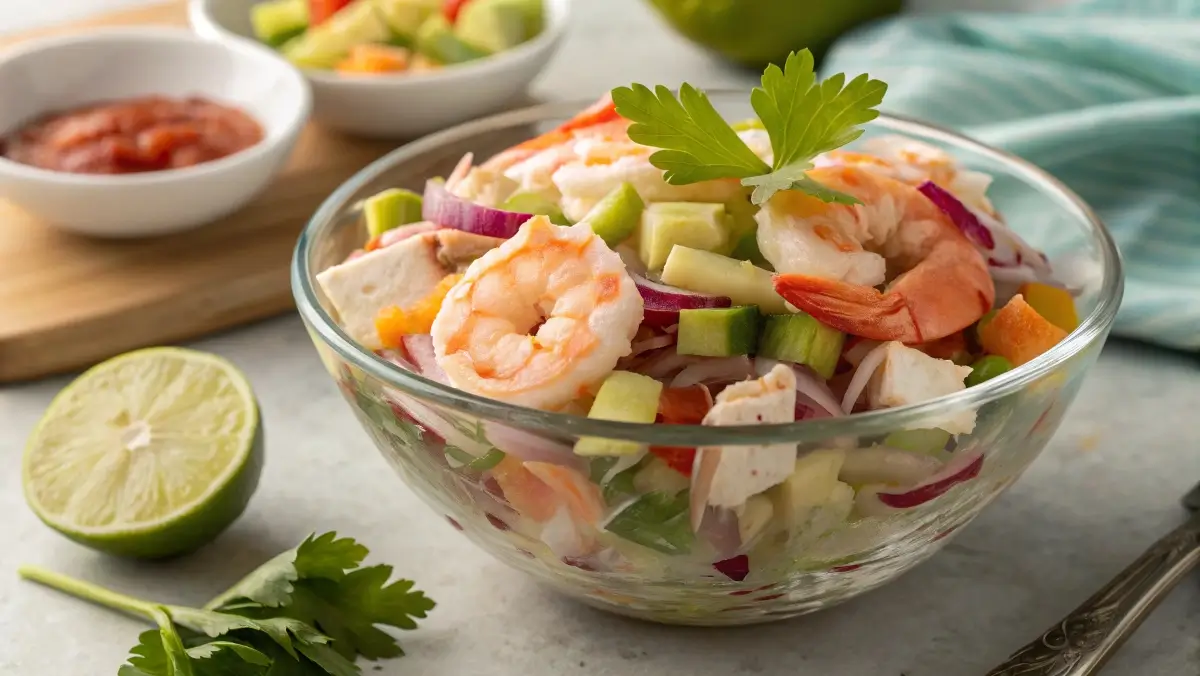Seafood Salad Recipe – A Complete Guide to the Best Flavors
Seafood salad is one of those timeless dishes that works for just about any occasion. Whether you’re preparing a light lunch, a family gathering, or a summer potluck, this recipe delivers fresh, savory flavors that everyone can enjoy. The best part? It’s highly versatile. You can keep it simple with shrimp and crab or go all out with scallops, calamari, and lobster. In this guide, you’ll learn everything from essential ingredients and step-by-step methods to smart variations and nutrition tips. We’ll also answer the most common questions about seafood salad, so you’ll feel confident making it at home. Looking for inspiration? Try this elote pasta salad recipe for another creative summer side dish.
Table of Contents
Introduction to Seafood Salad
What is a seafood salad recipe?
At its core, a seafood salad recipe blends fresh or cooked seafood with crisp vegetables and a flavorful dressing. Some versions are creamy with mayonnaise, while others lean toward a lighter citrus or vinaigrette style. The dish is usually served chilled, making it refreshing and perfect for warmer days. Depending on regional influences, you’ll find variations that highlight shrimp, crab, lobster, calamari, or a mix of all.
Why seafood salad is a favorite dish worldwide
Seafood salad is popular across cultures for a reason. It’s quick to prepare, packs a nutritious punch, and adapts to almost any flavor profile. Mediterranean versions may feature olive oil, lemon, and parsley, while American-style seafood salads often add mayonnaise, celery, and sometimes pasta. This flexibility is why the dish has become a staple at holiday tables, seafood buffets, and casual home kitchens alike. It’s also an easy way to enjoy the benefits of seafood without a complicated cooking process.
Key Ingredients for a Perfect Seafood Salad Recipe
Fresh vs. frozen seafood: What to choose
The first step to making an unforgettable seafood salad recipe is choosing your seafood. Fresh seafood often has a sweeter, cleaner taste, while frozen seafood offers convenience and a longer shelf life. Shrimp, crab, scallops, and calamari are all popular choices. If you go for frozen, make sure to thaw it properly in the refrigerator overnight to maintain texture and flavor. Check out this Perfectly Crispy Fried Cod Fish for tips on working with fresh fish in your kitchen.

Vegetables and herbs that complement seafood
The veggies you add will determine whether your seafood salad is light and crisp or hearty and filling. Common picks include celery, red onion, cucumbers, and bell peppers. Fresh herbs like dill, parsley, and cilantro add brightness, while a little green onion can give it a mild kick. For extra crunch, you can even toss in shredded cabbage or carrots.
Dressings and seasonings for flavor balance
Your dressing ties everything together. A creamy mayo-based dressing is rich and indulgent, while a lemon-olive oil vinaigrette feels light and zesty. Some cooks even mix the two for balance. Don’t forget seasonings like Old Bay, paprika, garlic powder, and a touch of mustard. Salt and pepper are essentials, but seafood also pairs well with a hint of cayenne if you like heat. Don’t miss our Rasta Pasta to explore another way to create a balanced dressing for chilled dishes.
Step-by-Step Seafood Salad Recipe
Preparing and cleaning seafood correctly
The success of any seafood salad recipe starts with preparation. If you’re using shrimp, peel and devein them before cooking. For crab meat, check for shell fragments, and if you’re using imitation crab, simply flake it apart. Calamari and scallops need a gentle rinse and quick cooking to avoid becoming rubbery. Always pat seafood dry with paper towels before mixing—it helps the dressing stick better. For more tips on handling seafood, check out this crispy Bang Bang Shrimp recipe that demonstrates proper cleaning and prep.
Mixing seafood with vegetables and herbs
Once your seafood is ready, place it in a chilled mixing bowl. Add diced celery, onions, cucumbers, and fresh herbs. The key is balance: seafood should remain the star, with vegetables adding crunch and freshness. Gently fold everything together so the seafood pieces don’t break apart. Looking for inspiration? Try this Easy Mediterranean Quinoa Salad to see how herbs and veggies can create vibrant flavors in chilled dishes.

Choosing the best dressing: creamy vs. light
Now it’s time for the dressing. A creamy base made with mayonnaise, Greek yogurt, or sour cream is classic, but lighter vinaigrettes with lemon juice and olive oil bring out the natural sweetness of seafood. Whisk the dressing separately, taste it, and then pour it gradually over the seafood mix. Stir gently to coat everything evenly. Don’t miss our Honey Roasted Cashews for another flavorful option you could adapt to seafood salad.
Variations of Seafood Salad Recipes
Shrimp salad recipe ideas
Shrimp is often the go-to choice for seafood salad recipes because it’s quick to cook and pairs beautifully with creamy or citrus-based dressings. You can boil, steam, or grill shrimp before chilling it. For a classic version, combine chilled shrimp with celery, onion, and a light mayonnaise dressing. If you want something refreshing, add avocado, cucumber, and lime juice. Learn more about fresh flavors by exploring this Mexican Street Corn Dip Crock Pot.
Crab salad with mayonnaise
Crab salad is another favorite, especially when paired with mayonnaise for a rich, creamy texture. Real lump crab meat adds sweetness and sophistication, while imitation crab provides a budget-friendly alternative. Mixing crab with mayo, celery, lemon juice, and Old Bay seasoning creates the perfect spread for sandwiches or a hearty topping for crackers.
Mixed seafood salad (shrimp, crab, calamari, scallops)
If you’re in the mood for variety, a mixed seafood salad lets you enjoy the best of everything. Combining shrimp, crab, scallops, and calamari makes for a show-stopping dish that works well at parties or holidays. A light lemon and olive oil dressing helps tie all the flavors together without overpowering them. For a hearty twist, you can toss the seafood over pasta or even leafy greens. Discover great ideas like this Old Fashioned Tuna Noodle Casserole to see how seafood and pasta work perfectly in chilled salads.
Tips and Tricks for the Best Seafood Salad
How to keep seafood fresh and flavorful
Freshness is the backbone of any seafood salad recipe. Always buy seafood from a trusted source, and if possible, use it within 24 hours of purchase. Keep seafood chilled on ice or in the refrigerator until it’s time to cook. If you’re storing cooked seafood for salad, cover it tightly and refrigerate for no more than two days. For an extra flavor boost, marinate shrimp or crab lightly in lemon juice before mixing.
Mistakes to avoid when making seafood salad
Overcooking is the number one mistake when preparing seafood for salads. Shrimp should be pink and firm but not rubbery, while scallops and calamari should remain tender. Another common error is overdressing—too much mayonnaise or vinaigrette can overpower delicate seafood flavors. Always start small and add more if needed. Finally, avoid skipping the chilling step, as seafood salad tastes best when it’s cold and flavors have blended.
Best storage methods for leftovers
Seafood salad doesn’t hold up as long as other salads because seafood is perishable. Store leftovers in an airtight container in the fridge and consume within two days. If you’re prepping ahead for a party, keep the seafood and dressing separate until just before serving. This prevents sogginess and keeps everything tasting fresh.
Serving Ideas for Seafood Salad
Seafood salad as a side dish
Seafood salad makes an elegant side dish for summer barbecues, picnics, or even holiday spreads. It pairs beautifully with grilled meats, roasted vegetables, or lighter pasta dishes. You can serve it in small bowls, over crisp lettuce leaves, or in hollowed-out avocados for a more upscale presentation. Discover great ideas like this Crockpot Italian Chicken Sandwiches to see how salads can shine alongside other mains.

Serving seafood salad as a main course
When made with shrimp, crab, or mixed seafood, this recipe can easily stand alone as a main dish. Simply serve larger portions with toasted bread, garlic crostini, or a bed of fresh greens. Some cooks also like adding pasta to bulk it up, turning it into a seafood pasta salad. For a comforting twist, don’t miss our Taste of Home Recipes, which shows how pasta and creamy dressings work together in a chilled dish.
Creative seafood salad appetizers
Seafood salad also works wonderfully as a party appetizer. You can spoon portions into mini pastry shells, serve in cucumber cups, or use as a topping for crackers. Another fun option is making seafood salad sandwiches or sliders for finger food. Looking for inspiration? Try this Delicious Shrimp Scallop for a different kind of seafood appetizer that’s just as crowd-pleasing.
Nutrition and Health Benefits of Seafood Salad
Protein and omega-3 benefits
One of the biggest advantages of making a seafood salad recipe is the nutritional boost it provides. Seafood like shrimp, crab, and scallops are all excellent sources of lean protein. They also contain omega-3 fatty acids, which support heart health, reduce inflammation, and contribute to brain function. Adding seafood salad to your weekly menu is a tasty way to fuel your body with essential nutrients.
Calories and diet-friendly seafood salads
Seafood salads can be surprisingly low in calories, especially when prepared with lighter dressings. A basic shrimp and vegetable seafood salad may have under 300 calories per serving, making it a great choice for those watching their weight. Switching from mayonnaise to Greek yogurt or olive oil-based dressings can reduce calories while keeping flavors rich and satisfying.
Substitutes for healthier versions
If you’re looking to make your seafood salad even healthier, there are plenty of smart substitutions. Swap mayonnaise for Greek yogurt, or use avocado as a creamy base. Instead of pasta, you can add quinoa or brown rice for extra fiber. For those watching sodium, season with lemon, dill, and herbs instead of salt-heavy mixes. These tweaks make seafood salad not just delicious but also diet-friendly for many lifestyles.
Conclusion and Final Thoughts
Seafood salad is more than just a quick side dish—it’s a versatile recipe that can be adapted for any occasion. Whether you prefer a creamy crab salad, a refreshing shrimp salad, or a deluxe mixed seafood version, the options are endless. With the right ingredients and a few simple techniques, you can create a dish that’s light, flavorful, and full of nutrition.
The beauty of this recipe lies in its flexibility. You can serve it as a side for a cookout, as a main dish for dinner, or as a creative appetizer at a party. Don’t be afraid to experiment with different seafood, dressings, and fresh vegetables to make it your own. Looking for inspiration? Try this Authentic Greek Lemon Rice Soup for another refreshing twist on classic chilled dishes.
At the end of the day, a seafood salad recipe is about bringing together fresh flavors in a simple, satisfying way. So grab your favorite seafood, mix it with crisp veggies, and enjoy a dish that always feels like a treat.
FAQs
What do you put in a seafood salad?
A traditional seafood salad recipe usually includes shrimp, crab, or a combination of seafood mixed with crisp vegetables like celery, onion, and cucumber. Fresh herbs such as dill or parsley add flavor, while a creamy mayonnaise-based dressing or a light vinaigrette ties it all together.
Do you put eggs in seafood salad?
Eggs aren’t a standard ingredient in seafood salad, but some variations do include them. Hard-boiled eggs can add extra protein and a creamy texture, especially in Southern-style recipes. It all comes down to personal preference.
Do you put eggs in shrimp salad?
Most shrimp salad recipes don’t include eggs, but they can be added for richness. If you enjoy egg salad, combining chopped hard-boiled eggs with shrimp, celery, and mayo creates a heartier dish.
What goes in crab salad with mayonnaise?
Crab salad with mayonnaise usually contains crab meat (fresh or imitation), mayo, celery, onion, and lemon juice. Some cooks add Old Bay seasoning or Dijon mustard for extra flavor. It’s a simple but classic seafood dish that can be served as a side, sandwich filling, or dip.
Do you put hard boiled eggs in crab salad?
While not traditional, hard-boiled eggs can be added to crab salad for a more filling dish. They add creaminess and protein, making the salad more substantial. If you’re making crab salad sandwiches, eggs can help hold the mixture together.
Is canned crab meat cooked?
Yes, canned crab meat is pre-cooked during the canning process. This makes it convenient for seafood salad recipes because you can simply drain it and mix it with your other ingredients without any additional cooking.

